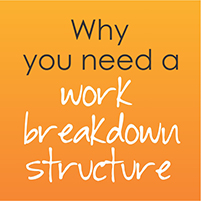 Work breakdown structure – that term used to make me cringe and it still does, to some degree. It sounds too rigid for my taste…too formal…too structured…too “official”. One definition of the WBS goes as follows: “A work breakdown structure (WBS) in project management and systems engineering, is a tool used to define and group a project’s discrete work elements in a way that helps organize and define the total work scope of the project.”
Work breakdown structure – that term used to make me cringe and it still does, to some degree. It sounds too rigid for my taste…too formal…too structured…too “official”. One definition of the WBS goes as follows: “A work breakdown structure (WBS) in project management and systems engineering, is a tool used to define and group a project’s discrete work elements in a way that helps organize and define the total work scope of the project.”
The WBS provides the project manager and team with the necessary task framework to not only create detailed cost estimates, but also detailed and accurate information for task scheduling. By going through the WBS motions, the project manager and team will have a pretty good idea of whether or not they’ve captured all the necessary tasks to get the job done, based on the project requirements.
In my opinion, there are four key benefits of developing a detailed WBS, and they are:
- It lays the ground work for the development of a detailed schedule and budget. A well-defined WBS enables resources to be allocated to specific tasks, helps in generating a meaningful schedule, and makes calculating a reliable budget easier.
- It forces the project manager, team members, and customers to delineate the steps required to build and deliver the product or service. This exercise alone encourages a dialogue that will help clarify ambiguities, bring out assumptions, narrow the scope of the project, and raise critical issues early on.
- It breeds excitement and commitment to the goals and completion of the project. Although the project manager will often develop the high-level WBS, he will seek the participation of his core team to flesh out its finer details. This participation will spark involvement in the project.
- It creates team and project stakeholder accountability for the completion of project tasks. With a defined WBS, people cannot hide under the “cover of broadness”. A well-defined task can be assigned to a specific individual, who is then responsible for its completion.
Are there any downsides?
The task of developing a WBS is not an easy one to undertake. It can be a painstaking process. And it can take quite a bit of time. A large WBS, containing potentially thousands of activities, can actually take many hours for you and your team to create. Of course, the larger the scope of the project, the larger the WBS will be. Plus, more people must provide input and then approve the portion they are responsible to perform. Finally, the WBS requires continual refinement, as the project changes, so does the WBS.
Summary
So, the downsides are that it can be hard to create, it can take a long time, and it will likely need periodic revisions. Even after considering these negatives, the overall advantages still outweigh the known challenges. A good WBS makes planning and executing a project easier and lays the groundwork for the schedule, tracking, budgeting, and accountability. It’s part of project management best practices to create one and to use it as you begin to map out the detailed project plan and solution. Don’t be tempted to skip this step!


